The Holy Month of Jihad? Measuring Terrorist Activity During Ramadan in the Post-9/11 Era.
Reinier Bergema and Lucie Kattenbroek [i]
Introduction
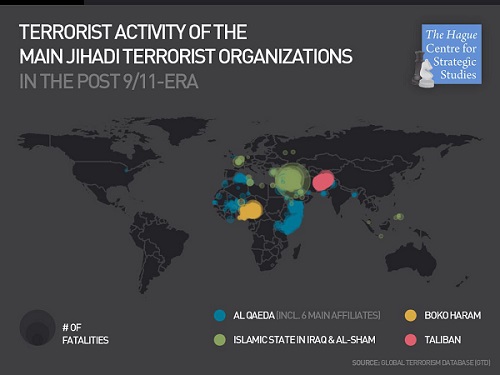
Overview Figure: Terrorist Activity of Main Jihadi Terror Groups in the Post-911 Era
During the spring of 2016, an audio message surfaced, purportedly coming from Abu Muhammad al-Adnani, the former leading propagandist of the Islamic State in Iraq and al-Sham (ISIS). Therein he called for attacks on military and civilian targets during the holy month of Ramadan.[ii] Although pressure on the ISIS Caliphate was mounting, his call would not fall on deaf ears.
On June 12, 2016, roughly a month after the audio message and a week after the start of Ramadan, Florida resident Omar Mateen opened fire at Pulse nightclub in Orlando, killing 49 people and injuring another 53.[iii] Barely two weeks later, on June 28, ISIS’ gunmen, armed with Kalashnikov rifles and suicide vests, attacked Istanbul Atatürk Airport, killing 45 people.[iv] And only days before Eid al-Fitr, which marks the end of Ramadan, on July 3rd a suicide car bomber killed 383 people in Baghdad's Karrada district.[v] This was the bloodiest terrorist attack in Baghdad’s history and the second deadliest attack worldwide in 2016.
Although Ramadan is the month of repentance and a time of unity and solidarity for Muslims worldwide, terrorist organizations, such as ISIS and al-Qaeda, take this opportunity to call for terrorist attacks, labelling it “the month of conquest and jihad”.[vi] Attacks during Ramadan fit the strategic rationale of such organizations, as it allows them to showcase their operational capacity. Equally they are also attractive from the perpetrators’ perspective, as they are expected to receive double the reward during the holy month.[vii]
Media outlets are keen to attribute terrorism during Ramadan to the holy month. While calls for attacks are far from uncommon, few receive media attention, unlike al-Adnani’s call. In the wake of the June 2017 London Bridge attack, Dr. Sajjan Gohel warned that the West should “brace themselves” and prepare for a wave of terrorist attacks, “especially during Ramadan”.[viii] And the 2018 Ramadan has not been exonerated from terrorism-related violence either, as Kandahar,[ix] Liege,[x] Muqokori,[xi] and Baghdad[xii] amongst others were the scene of jihadist bloodshed.
However, notwithstanding a few valuable exceptions,[xiii] the evidence for a relation between Ramadan and increased terrorist activity has been inconclusive and, more importantly, mostly anecdotal. Terrorist attacks during Ramadan are not uncommon, but neither are terrorist attacks in the remainder of the year. So, what does the data show? Does the holy month actually entail a higher risk of terrorist attacks?
Measuring Terrorist Activity During Ramadan
To enhance the structural understanding of the relation between terrorist activity and the holy month of Ramadan,[xiv] the authors have analysed 25,360 terrorist attacks since 9/11 by 81 terrorist organizations, using data from the Global Terrorism Database (GTD).[xv] To do so, a distinction was made between jihadi terrorist organizations on the one hand, and terrorist organizations driven by different (religious or ideological) motivations on the other. The latter has been excluded from the analysis, to minimize noise in the data.[xvi] Moreover, it should be noted that the data in the GTD does not necessarily offer any insight in the underlying motivations or operational considerations for the attack itself, so some generalization is necessary.
Despite these caveats, a brief analysis shows that, while the average attack during Ramadan is not necessarily more deadly (5.1 vis-a-vis 5.2 fatalities per attack, respectively), the average number of attacks during Ramadan in the post-9/11 era is indeed fifteen percent higher than throughout the remainder of the year (see Figure 1, Figure 2).
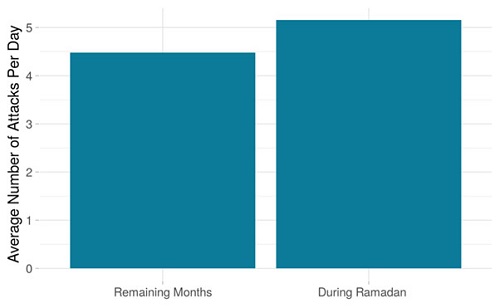
Figure 1. # of Jihadi Terrorist Attacks Per Day, 2001-2016 (Source: GTD)
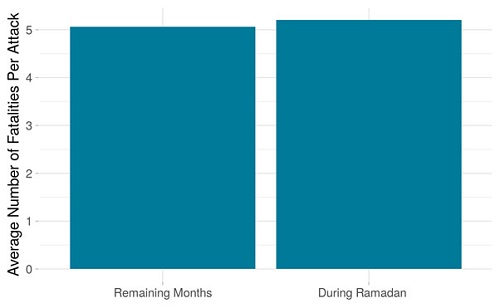
Figure 2. # of Jihadi Terrorism-Related Deaths Per Attack, 2001-2016 (Source: GTD)
Trends in Terrorist Activity During Ramadan
Drawing the conclusion that there is a causal link between Ramadan and an increase in violence by approaching Ramadan as a dichotomy (Ramadan days versus non-Ramadan days) would be both premature and overly simplistic. This approach would neglect important contextual factors of terrorist activity. Moreover, a brief analysis of counts does little to understand developments over time. Terrorism is flexible: its character is likely to change continuously.
Separating the data post 9/11 by month shows a gradual increase in jihadi terrorism over time, with a surge in attacks from 2012 onwards. Unsurprisingly, this increase is partially the result of the ongoing political instability in the wider MENA region following the Arab Spring, in particular the violent escalation of the Syrian conflict, as well as the rise of ISIS and the increased activity of Boko Haram in Nigeria.
Additionally, separating the date by month also confirms recent observations by Amarnath Amarasingam and Charlie Winter,[xvii] Pieter van Ostaeyen,[xviii] and Sajjan Gohel,[xix] that since 2012, Ramadan has frequently been more violent (see Figure 3, 4). This recent surge in Ramadan terrorist activity should be considered in the context of the global increase of terrorist activity. The number of terrorist attacks during Ramadan between 2001 and 2011 has frequently been lower or roughly equal to the annual mean. Although post-2012 the number of terrorist attacks tends to be towards the upper limit, only in 2013 and 2014 has the holy month endured the highest number of attacks. Notably, the 2014 peak was at the zenith of ISIS’ military conquest and coincides with the proclamation of the Caliphate by Abu Bakr al Baghdadi (June 29, during Ramadan).
Furthermore, the hypothesis suggests a significant but discontinuous increase in terrorist activity during the holy month: relatively consistent terrorism in other months, with an otherwise unexpected surge during Ramadan. This is not the trend that can be observed. On the contrary: there are cyclical trends around the festival, violence rising in the lead up to Ramadan and decreasing afterwards. Interestingly, these peaks seemingly indicate seasonal patterns, as they broadly coincide with the summer months, in which terrorist activity tends to be higher.[xx] Since 2007, Ramadan overlaps with the astronomical summer, which starts on June 21st.[xxi] It is only since 2012 that it can be clearly seen that the number of terrorist attacks during the holy months is in the upper percentiles of the annual average. From 2015 onwards, the number of terrorist attacks during (and outside) Ramadan seems to decrease, although it would be premature to suggest a downward trend.
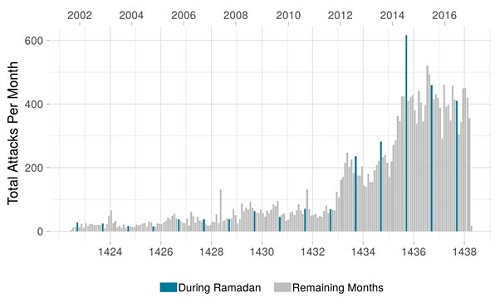
Figure 3. # of Jihadi Terrorist Attacks Per Month, 2001-2016 (Source: GTD)[xxii]

Figure 4. # of Jihadi Terrorist Attacks Per Month, 2012-2016 (Source: GTD)
Terrorist Activity of Main Jihadi Terrorist Organizations During Ramadan
Since 2001, al-Qaeda (16.8%),[xxiii] Boko Haram (8.2%), ISIS (16.9%), and the Taliban (25.8%) have been responsible for approximately two-thirds of all jihadi terrorist attacks worldwide. When further focusing on their activity, some key differences stand out. The activities of the Taliban and, to a lesser extent, Boko Haram seem to follow the cyclical pattern aforementioned, with an increase in activity during the summer period and a decrease in activity during the winter period (see Figure 5; top right, bottom right).[xxiv]
With ISIS, terrorist activity is usually above the annual average during Ramadan,[xxv] but it is not necessarily the period with the highest activity over the year (see Figure 5; bottom left).
The available data for ISIS shows significantly less of a pattern than is present for the Taliban and Boko Haram. This is perhaps unsurprising given the turbulent rise and fall of the organization, and their ongoing presence in Iraq and Syria. The most notable pattern is the increase that seemingly followed the proclamation of the Caliphate, although this increase remained relatively consistent in the months after.
Of the four main terrorist organizations, al-Qaeda appears to be most active during the month of Ramadan, especially in 2014, where the number of terrorist attacks surged and nearly doubled compared to the month(s) before (see Figure 5; top left). During the 2014 Ramadan, there was a significant increase in terrorist activity by Al-Shabaab (180 out of 209 total attacks by al-Qaeda, 616 attacks in total), which carried out a series of attacks in Somalia. Although Al-Shabaab’s 2014 Ramadan offensive was preceded by intensified military operations by the Somali government, supported by African Union troops (March 2014),[xxvi] the increased terrorist activity was also announced by Sheik Ali Mohamed Hussein. As one of the group’s commanders, he vowed to “scale up strikes on the enemies” during the holy month.[xxvii] Interestingly, the proclamation of the Caliphate by ISIS, the same year, did not necessarily lead to an increase of terrorist activity by al-Qaeda’s Syrian franchise, the al-Nusrah Front, despite their fierce rivalry with ISIS.
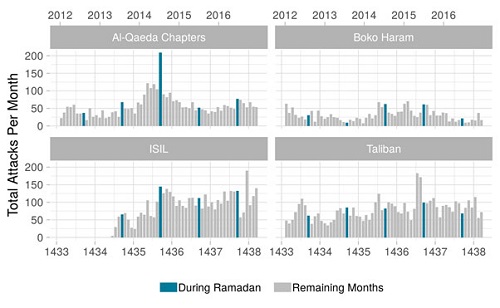
Figure 5. # of Jihadi Terrorist Attacks Per Month by al-Qaeda, Boko Haram, ISIS and the Taliban (Source: GTD).
Conclusion
The holy month of Ramadan has not remained immune to the violence of jihadist terrorism, but equally the month itself has not become a bastion of terror. Organizations such as al-Qaeda and ISIS have frequently called for attacks during the holy month, and it would be naïve to think that it’s not possible that this has had an effect. After all, both organizations have a global reach and have proven themselves capable of orchestrating and inspiring terrorist attacks worldwide.
However, despite the attempts of these certain factions within ISIS and al-Qaeda, there is little indication that there is a dramatic increase in terrorist attacks during the month of Ramadan. The data suggests that the number of attacks during the holy month is higher than the yearly average, but it is unlikely to be the month with the single highest number of attacks over the year. This may lend some support to the initial hypothesis that there are greater numbers of attacks during Ramadan, but to immediately draw this conclusion is to assume an overly simplistic interpretation of events.
The data has shown that there tends to be a gradual increase in attacks in the months leading up to Ramadan, and decrease in the months after, fluctuating throughout the year. This is unlikely to be entirely dependent on the Islamic calendar, but rather may indicate the effect of seasonal conditions on acts of terror. The most notable Ramadan-time spike in violence occurred with al-Qaeda in 2014, where the al-Shabaab offensive was seemingly deliberately timed in coordination with the holy month. However, similar examples have not been seen for other terror organizations.
Despite this lack of meaningful correlation between terror attacks and the month of Ramadan, media outlets have frequently drawn links between the two. By pursuing this narrative, they may unwittingly propagate the aims of jihadist groups, which are keen to draw parallels between the current violence and the holy wars of yesteryear. Conflating the holy month with terrorism only helps to further the ‘us vs. them’ narrative disseminated by these jihadist groups, particularly when there is minimal statistical evidence in favour of the link. Paradoxically, for many Muslims, the call for such attacks during the holy month alone is enough evidence that these organizations do not represent Islam.
There is a lack of clear causation between the holy month and terrorist attacks. Although individual months of Ramadan have been especially violent, the fact that they are rarely the most violent months of the year shows that to claim a clear causation is inaccurate. This enduring myth of Ramadan being a time of jihadist violence only serves to further the causes of these groups, and the misleading nature of the connection can only add to the divisions already established in society.
End Notes
[i] Special thanks go out to Matthew Phillips, for his editorial work on this article.
[ii] “Islamic State Calls for Attacks on the West during Ramadan in Audio Message,” Reuters, May 21, 2016, https://www.reuters.com/article/us-mideast-crisis-islamicstate-idUSKCN0YC0OG.
[iii] Global Terrorism Database, Pulse Nightclub Attack, Orlando, United States (June 12, 2016). https://www.start.umd.edu/gtd/search/IncidentSummary.aspx?gtdid=201606120001
[iv] Global Terrorism Database, Ataturk Airport Attack, Istanbul, Turkey (June 28, 2016). https://www.start.umd.edu/gtd/search/IncidentSummary.aspx?gtdid=201606280001
[v] Global Terrorism Database, Karada bombing, Baghdad, Iraq (July 3, 2016). https://www.start.umd.edu/gtd/search/IncidentSummary.aspx?gtdid=201607020002
[vi] “Islamic State Calls for Attacks on the West during Ramadan in Audio Message.”
[vii] Amarnath Amarasingam and Charlie Winter, “ISIS’s Perverse, Bloody Interpretation of Ramadan,” The Atlantic, May 26, 2017, https://www.theatlantic.com/international/archive/2017/05/ramadan-isis-attack-muslim/528336/.
[viii] Eleanor Rose, “London Terror Attack: ‘Brace Ourselves’ for Further Attacks, Says Security Expert,” Evening Standard, June 4, 2017, https://www.standard.co.uk/news/london/london-terror-attack-brace-ourselves-for-further-attacks-says-security-expert-a3556531.html.
[ix] “Heavy casualties as blast rocks Afghan city of Kandahar,” Al Jazeera, May 22, 2018, https://www.aljazeera.com/news/2018/05/afghanistan-kandahar-city-hit-deadly-minibus-bomb-explosion-180522091836785.html
[x] Milan Schreuer, “Belgian Inmate on Leave Kills 3 in Liège Attack,” The New York Times, May 29, 2018, https://www.nytimes.com/2018/05/29/world/europe/liege-belgium-attack.html
[xi] Feisal Omar & Abdi Sheikh, “Al Shabaab fighters seize town in central Somalia: residents,” Reuters, June 2, 2018, https://www.reuters.com/article/us-somalia-security/al-shabaab-fighters-seize-town-in-central-somalia-residents-idUSKCN1IY0F4
[xii] Ahmed Aboulenein & Huda Majeed, “At least 18 killed in Baghdad explosion: source,” Reuters, June 6, 2018, https://www.reuters.com/article/us-iraq-blast/at-least-18-killed-in-baghdad-explosion-source-idUSKCN1J22NK
[xiii] See: “Relation Terrorism Attacks and Ramadan,” Datagraver, July 4, 2016, http://www.datagraver.com/case/relation-terrorism-attacks-and-ramadan; Erin Miller et al., “Background Report: Patterns of Islamic State-Related Terrorism, 2002-2015” (National Consortium for the Study of Terrorism and Responses to Terrorism (START), August 2016), https://www.start.umd.edu/pubs/START_IslamicStateTerrorismPatterns_BackgroundReport_Aug2016.pdf.
[xiv] Deciding whether an event was during Ramadan or not is not trivial. Ramadan is the ninth month of the Hijri calendar, a lunar calendar. Because the lunar calendar is a few days shorter than the solar (Gregorian) calendar, Ramadan shifts through the Gregorian year. A complicating factor is that the start of a new month depends on the observance of the crescent moon. Hence, it is not uncommon that the start of Ramadan differs per region. In this research, dates from www.islamicfinder.org were used.
[xv] For further information on their metholodogy, see: https://www.start.umd.edu/gtd/downloads/Codebook.pdf
[xvi] In order to make this classification, the authors have relied on the START BAAD (Big, Allied and Dangerous) online platform as primary source, and on a RAND report published in 2008 titled ‘How Terrorist Groups End’ as secondary source. The remainder was assessed through judgement of the authors and only included if the group can convincingly be stated to be motivated by Jihadist views. Additionally, 10 attacks since 9/11 attributed to these organizations has been taken as a minimum. Ultimately, of the 262 terrorist organizations with ≥10 attacks, 81 are considered to be jihadi terrorist organizations.
[xvii] Amarasingam and Winter, “ISIS’s Perverse, Bloody Interpretation of Ramadan.”
[xviii] “‘Vaak Aanslagen Door IS Aan Begin van de Ramadan,’” NOS, May 30, 2017, https://nos.nl/artikel/2175817-vaak-aanslagen-door-is-aan-begin-van-de-ramadan.html.
[xix] Rose, “London Terror Attack: ‘Brace Ourselves’ for Further Attacks, Says Security Expert.”
[xx] “Relation Terrorism Attacks and Ramadan.”
[xxi] The astronomical summer in the Southern Hemisphere starts on December 21st.
[xxii] Data is analyzed on the basis of the Islamic calendar - Gregorian years are added as reader’s guide.
[xxiii] This number includes attacks from terrorist organizations strongly affiliated with al-Qaeda, i.e., al-Shabaab, the al-Nusra Front, al-Qaeda in the Arabian Peninsula (AQAP), al-Qaeda in the Islamic Maghreb (AQIM), the Abdullah Azzam Brigades, and al-Qaeda in the Indian Subcontinent.
[xxiv] It should be noted that Nigeria, just like other parts of Western Africa, has only two season: the wet season (November-March), with higher temperatures, and the dry season (April-October), which tends to be relatively cooler.
[xxv] Miller et al., “Background Report: Patterns of Islamic State-Related Terrorism, 2002-2015.”
[xxvi] “AMISOM and Somali National Army Drive Al Shabaab out of Six Towns,” AMISOM, March 2014, http://amisom-au.org/2014/03/amisom-and-somali-national-army-drive-al-shabaab-out-of-six-towns/.
[xxvii] “Shabaab Warn of Attacks during Ramadan,” News24, June 30, 2014, 24, https://www.news24.com/Africa/News/Shabaab-warn-of-attacks-during-Ramadan-20140630.
